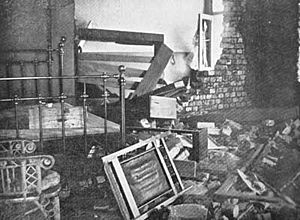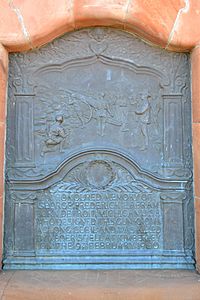George Labram facts for kids
Quick facts for kids
George Frederick Labram
|
|
|---|---|

Labram leaning on Long Cecil
|
|
| Born | 1859 Detroit, United States
|
| Died | 1900-02-09 Grand Hotel, Kimberley, Cape Colony
|
| Cause of death | Shrapnel from artillery shell |
| Resting place | Gladstone cemetery, Kimberley |
| Occupation | Engineer |
| Employer | De Beers |
| Known for | Construction of Long Cecil gun during the Siege of Kimberley Invention of new diamond mining techniques |
George Labram (1859-1900) was a talented American engineer. He worked as the main engineer for the De Beers diamond mines in Kimberley, South Africa. He became famous during the Siege of Kimberley, a big event in the Second Boer War. Labram helped defend the city by inventing and building many useful things.
Early Life and Career
George Labram was born in Detroit, Michigan, in 1859. When he was about five years old, his family moved to Quincy Mine. He later started his career working for different companies in places like Detroit and Chicago.
In 1893, Labram joined the De Beers company in Kimberley. His job was to build and manage a special crushing mill. By 1898, he was promoted to chief engineer. Under his guidance, a new way to find diamonds was created. Before this, people had to find diamonds by hand.
Helping During the Siege of Kimberley
The city of Kimberley was under attack during the Second Boer War in 1899. This attack was called the Siege of Kimberley. George Labram played a very important role in helping the city.
He helped prepare Kimberley's defenses. He built a tall watch tower, bright searchlights, and a telephone system. He also set up a new fresh-water system for the town. This was very important because water supplies were limited. Labram also designed a large refrigerator to store food. This helped keep meat fresh for the people stuck in the city.
Building Long Cecil
During the siege, Labram also built two armoured trains. These trains helped move soldiers and supplies safely. He also made ammunition for the guns the city already had.
But his most famous creation was a powerful cannon. It was named Long Cecil after Cecil Rhodes, who was in charge of De Beers. Labram and his team had to make many of the tools needed to build this gun right there in the De Beers workshop.
Long Cecil was a big gun. It could shoot a 28.5-pound shell over 6,500 yards (about 6 kilometers).
Sadly, George Labram was killed on February 9, 1900. This was less than a week before the siege ended. A Boer shell hit his room in the Grand Hotel. He was given a full military funeral. Thousands of people attended, even though the Boers were still shelling the city.
After his death, the De Beers company took care of Labram's wife and son. His wife received money every year, and his 13-year-old son received money until he grew up. Great Britain also gave his wife a large sum of money for his help during the siege.
The commander of the troops in Kimberley, Lieutenant-Colonel Kekewich, wrote a letter to Mrs. Labram. He said that George Labram's "great genius" had helped them defend Kimberley for nearly four months. He also said that the whole city mourned Labram's loss.
Legacy
Today, a part of Kimberley is named Labram in his honor. The Long Cecil gun, which he built, is now part of the Honoured Dead Memorial. This memorial also has a special plaque for George Labram.
The plaque says:
IN HONOURED MEMORY OF
GEORGE FREDERICK LABRAM
BORN DETROIT MICHIGAN USA
WHO DESIGNED THIS GUN KNOWN
AS LONG CECIL AND WAS KILLED
BY A BOER SHELL AT KIMBERLEY
ON THE 9TH FEBRUARY 1900




